Page contents
- Key building blocks and principles: informing future options and choices
- Identifying potential building blocks
- Building block 1: existing urban areas
- Building blocks beyond our urban areas
- Building block 2: expanding our main urban areas through small or large urban extensions
- Building block 3: growth around our market towns
- Building block 4: rural villages and settlements
- Building block 5: large scale free standing new settlements
- Building block 1: existing urban areas
- Investigating the Green Belt?
- Developing a growth strategy: potential guiding principles
- 1. Locate new homes, jobs or settlements in places where key services and facilities are easily accessed by walking and cycling or effective public transport, or alternatively in locations where key services and facilities are capable of being provided as part of the new development
- 2. Sequential approach to building on areas at a high risk of flooding
- 3. Protect and enhance ecological, landscape and heritage designations and their settings.
- 4. Protect and enhance the function and connectivity of our Green Infrastructure and Nature Recovery Networks.
- 5. Plan for a better balance between local jobs and resident workers in our communities
- 6. Ensuring that we protect a ‘sense of place and character’ when we plan for new development
- 1. Locate new homes, jobs or settlements in places where key services and facilities are easily accessed by walking and cycling or effective public transport, or alternatively in locations where key services and facilities are capable of being provided as part of the new development
- What happens next?
- Questions and comments
Local Plan 2020 Phase 1 consultation
A key theme of this consultation is how we begin to look at the opportunities and challenges of providing a significant number of new homes, jobs and new infrastructure in South Gloucestershire.
The choices we make about where we put new development and where we protect will form the basis of a new growth strategy for the Local Plan 2020. This strategy eventually needs to set out where in South Gloucestershire we locate a large number of new homes, space for jobs, supporting services, facilities and infrastructure.
The current strategy for growth of new homes and jobs is set out in the Core Strategy, Policy CS5 (Location of Development). You can read more about the current strategy approach in the context section of this document.
To respond effectively to changes in local circumstances and the issues facing South Gloucestershire we need to develop a new strategy.
This strategy will need to be in conformity with the Spatial Development Strategy (SDS) currently being prepared by the West of England Combined Authority (WECA). The Issues and Priorities section, issue 27 and 36, explains more about this, and how the SDS will establish the overall amount of housing and jobs required in the West of England.
Key building blocks and principles: informing future options and choices
To help support the work of the SDS, we think our plan-making should begin with investigating initial ’building blocks’ and potential ’guiding principles’ that could shape our new growth strategy. These building blocks and principles can then assist us to make choices.
As our new Local Plan progresses, the building blocks and guiding principles will help to guide and inform which locations have the potential to be considered as realistic options for the sustainable development of new homes, jobs, key services, facilities and infrastructure in South Gloucestershire.
The next section is split into two parts:
- identifying the potential building blocks
- potential guiding principles for growth
In developing our growth strategy, we will aim to:
- meet the agreed requirements for new homes and jobs that will be set out in the SDS, by putting our commitment to a green economic recovery post Covid-19 and to restore and enhance the natural environment at the heart of our approach to identifying sites and areas of growth for new homes and jobs within South Gloucestershire.
- provide new homes and jobs that offer affordability and choice across a wide range of locations and site sizes, throughout the district, and ensure the timely provision of those homes and jobs with essential infrastructure.
- improve the longer-term health, well-being and sustainability of our communities by ensuring that new and existing places offer a balance of new homes and jobs, built around a high quality, natural and built environment and the opportunities this provides for physical activity, including children’s play, walking and cycling, access to formal and informal community meeting spaces and green spaces.
Identifying potential building blocks
Building block 1: existing urban areas
The first building block we need to fully explore is further development of land in our existing urban areas.
National Planning Policy requires our new growth strategy to include a focus on our urban areas, including brownfield sites and optimising the level of new homes, jobs and services that come forward on urban sites. However, increasing the amount of future growth in our urban areas will also need to positively address inequalities, the quality of built and natural environments, and regenerate our town centres, high streets and urban areas. To achieve growth in our urban communities, and have positive outcomes will require new approaches to development.

We will therefore be looking to:
- optimise the density, efficient use of land and mix of uses within existing settlement boundaries, where consistent with our ambition of creating great places to live and work. It is suggested this is done in the urban areas of the Bristol North and East Fringe, Yate and Thornbury.
- promote and direct opportunities to co-ordinate renewal, investment, new uses and development in and around our urban town centres and high streets, to ensure that they remain vibrant, viable and serve local community’s needs, now and into the future.
- support the ambitions of a ‘green economic recovery’ to improve and benefit the local and regional economy.
Our emerging approach to planning for further growth in our urban areas is explored further in section 6 of this document ‘Urban Lifestyles’.
Building blocks beyond our urban areas
We must emphasise that at this point no decisions have been made. However, the likelihood of meeting all of our needs for new homes and jobs in the urban areas, with Building block 1, is low. There will only be so much development that renewal, regeneration and re-use of urban and brownfield land can provide. There will also be a need to ensure development in urban areas does not lead to negative impacts on the quality of life, economy and sustainability of our existing urban communities. Other areas of South Gloucestershire may also benefit from growth to improve or maintain their longer-term sustainability as mixed and balanced communities and provide a choice of new homes, including affordable ones.
To ensure that we maintain a good quality of life for those who live, work and visit urban South Gloucestershire, we need to consider where else in our area should be investigated for planned growth. At this stage, we want to begin discussing and investigating the basic choices available to us.
National policy suggests that where large numbers of homes and jobs are required, and the level of growth can’t be accommodated from the re-use of brownfield land, greenfield extensions to urban areas, towns and villages may offer the next best opportunity in meeting need.
As we begin considering how to prepare a strategy for growth of homes, jobs, facilities and services in South Gloucestershire, it is likely that focused development in greenfield and rural areas of the district, including around our market towns, rural villages and settlements, will need to be investigated.
With the Plan at such an early stage, it is not appropriate to identify individual locations, or specify how much growth should be apportioned to certain places. Until such time as the overall growth target for new homes and jobs is known, and the call for sites and other evidence work has been concluded, we currently have an incomplete understanding of where potential options for new development might be.
However, what we do know is we have basic building blocks that are available to us to start considering and investigating growth which our new Local Plan will need to accommodate.
In considering our building blocks, we do have choices, and we will need to investigate if all, or just some, are appropriate and needed. Our future growth strategy could combine places within each building block, where they support our Plan priorities for climate change, our environment, the creation of exceptional places and the improvement of health and well-being.
The choice of building blocks, would be in addition to further development in our urban area (Building block 1) and as a starting point might include:
Building block 2: expanding our main urban areas through small or large urban extensions
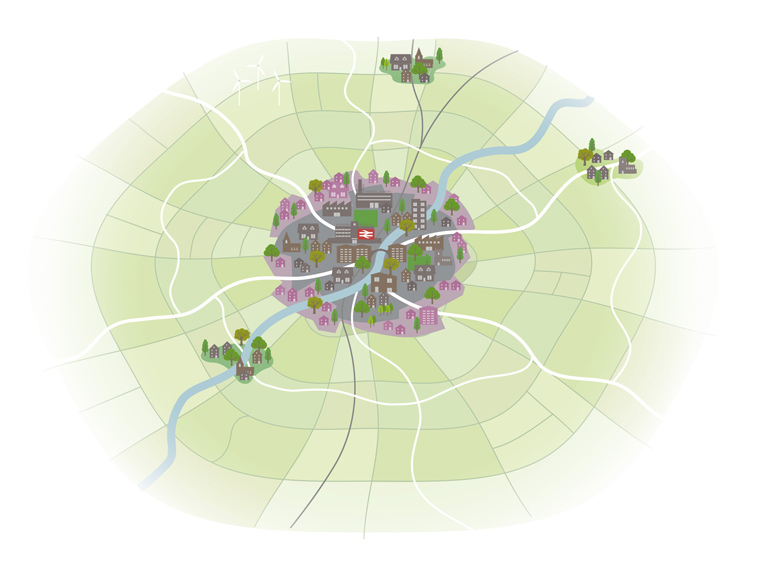
This building block would see expansion into locations beyond the communities of the North and East Fringe, to meet the needs for new homes and jobs. In most cases, it would require development of land currently in the Green Belt.
Building block 3: growth around our market towns
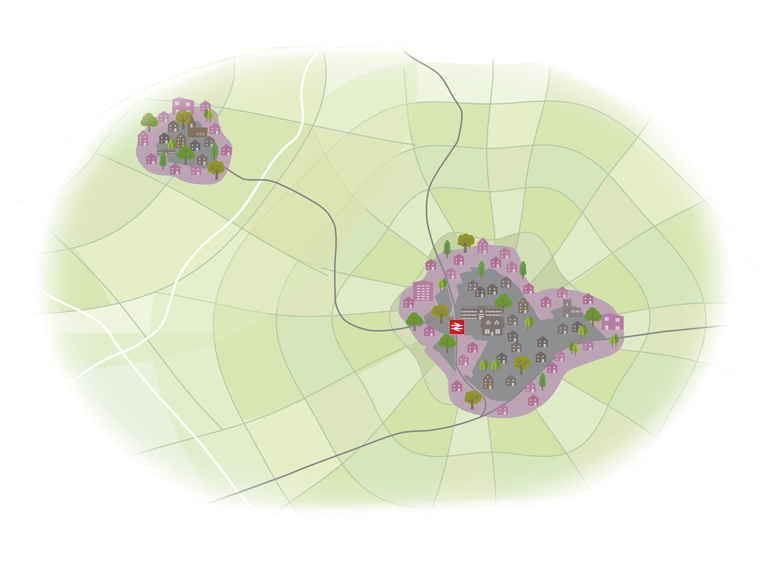
Under this building block, the potential for sustainable growth would be investigated around the edges of our three market towns. This would investigate development beyond the existing settlement boundaries at Yate, Chipping Sodbury and Thornbury.
These locations include land currently designated as Green Belt and land outside of the Green Belt.
Building block 4: rural villages and settlements
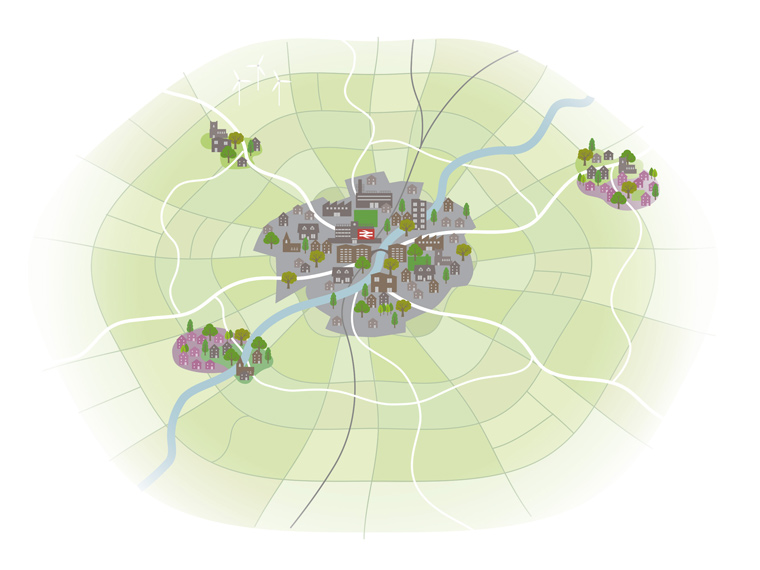
This building block would investigate the potential for an appropriate level of sustainable growth (large scale or small and medium scale) in and around the wide range of rural villages and settlements in the district.
Some of these villages and settlements are in the Green Belt, some are outside of the Green Belt and a number of our villages and settlements are ‘washed over’ by the Green Belt. Some of our villages in the east of the district, also lie within the Cotswolds Area of Outstanding Natural Beauty (AONB).
How we might approach and investigate the appropriate level of small and medium scale growth in our rural villages and settlements is discussed in section 7 of this document.
There may also be potential to deliver larger-scale growth in some of our rural villages and settlements instead of, or in addition to, any proposals for small and medium-scale growth.
Building block 5: large scale free standing new settlements
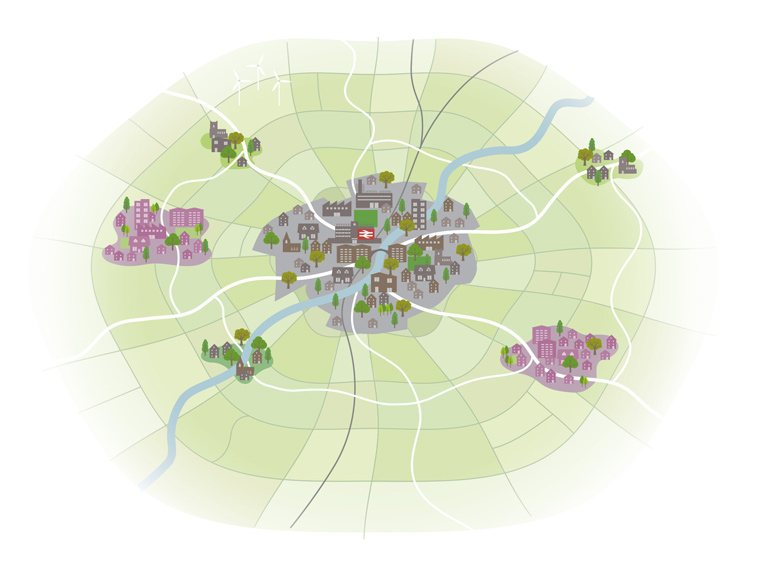
The opportunity to consider new settlements is another building block, and could cover any large greenfield area in the district. Locations may be within or outside of the Green Belt.
Large sites like this will require careful investigation to support the delivery of sustainable new communities, like the necessary provision of key infrastructure, services and facilities. The relationship of any new proposed settlement to existing settlements will also need to be considered.
Investigating the Green Belt?
Many of our rural communities, or land in rural areas, including our market towns are located close to the urban edge of Bristol where new proposals could be supported by high levels of walking, cycling and effective public transport to key services and facilities.
However, much of this land is currently designated as Green Belt.
Balancing the need for new homes, jobs, services and facilities with the need for sustainable development particularly becoming carbon neutral in line with the climate emergency, may require areas of Green Belt to be investigated.
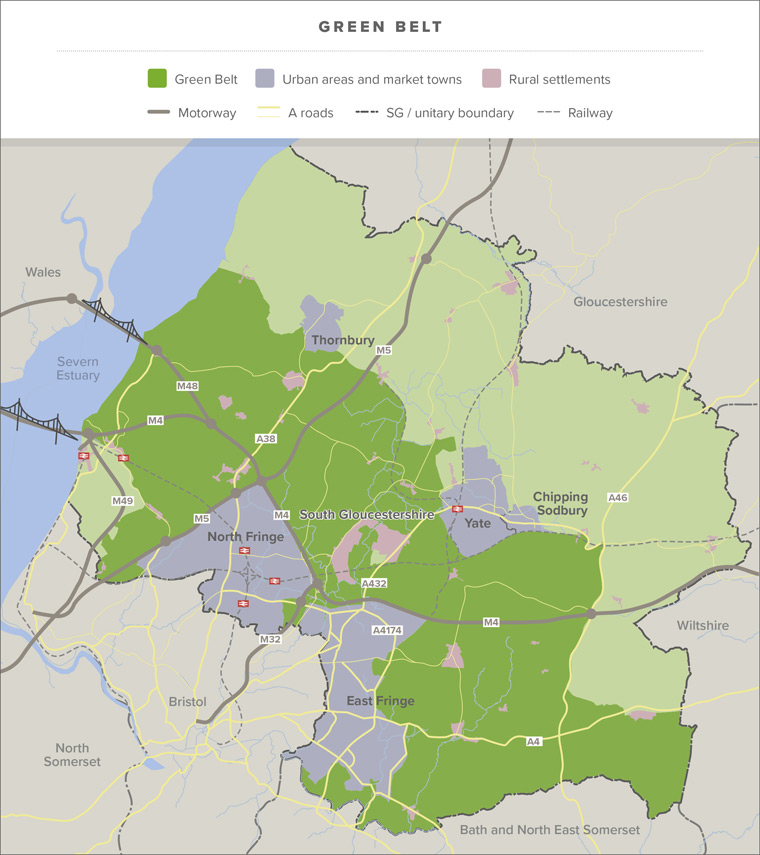
All of our Building Blocks, with the exception of further urban development might include investigation of Green Belt locations. Building block 2, urban extensions would require use of Green Belt land. Maximising opportunities to provide land for renewable energy generation, green infrastructure and Nature Recovery Networks also needs to be recognised and supported where possible within Green Belt areas.
However, in line with national guidance, consideration should only be given to building on Green Belt land after brownfield, urban and non-Green Belt options, including any potential capacity within our neighbouring authorities, have first been investigated.
Developing a growth strategy: potential guiding principles
To inform the development of a new growth strategy, when we begin investigation of our initial building blocks and the individual locations within them, we could look to apply six, potential, guiding principles. These principles will help us assess the suitability of the different locations to accommodate new growth, while helping to meet the ‘Potential Priorities’ discussed in Section 4 of this document.
These are initial ideas, which we want to discuss and share with you. The guiding principles we apply will need to be consistent with those set out in the sub-regional SDS, which is currently under development.
1. Locate new homes, jobs or settlements in places where key services and facilities are easily accessed by walking and cycling or effective public transport, or alternatively in locations where key services and facilities are capable of being provided as part of the new development
This will consider proximity of potential locations to key services and facilities, train stations (existing and planned), key public transport corridors, the strategic cycle network and key walking routes. It is possible that new services, facilities and transport infrastructure may come forward during the Plan period. These could provide new and improved opportunities for some communities to access a greater variety of key facilities and services.
As part of this principle, the larger the scale of growth proposed, the more local services and facilities, including opportunities for local employment would be expected to be provided. These should be accessible by walking and cycling.
By locating the growth of new homes and jobs in locations that avoid creating a reliance on private car journeys, and instead, promote walking, cycling and effective public transport use, suggested Plan priorities can be assisted relating to “pursue a carbon neutral and resilient future in a changing climate”, “achieving sustainable travel”, promoting health and well-being”, and “ensuring the timely and efficient provision of infrastructure to support growing communities”

2. Sequential approach to building on areas at a high risk of flooding
A large area of the district falls within Flood Zone 3 (highest risk) and Flood Zone 2.
22% of land within the district falls within Flood Zone 3 (highest risk) as well as 29% in Flood Zone 2. Key areas at risk include land along the Severn Estuary, the Avonmouth & Severnside Enterprise Area, the villages of Severn Beach and Pilning and a number of smaller settlements.
The high risk zones are mostly in the area next to the Severn Estuary. Climate change is likely to have an impact on flood risk, in particular, by increasing the extent of an area at highest risk, as well as the frequency of potential flood events. One of the Plan’s priorities is to “pursue a carbon neutral and resilient future in a changing climate” and we need to plan accordingly to deal with this.
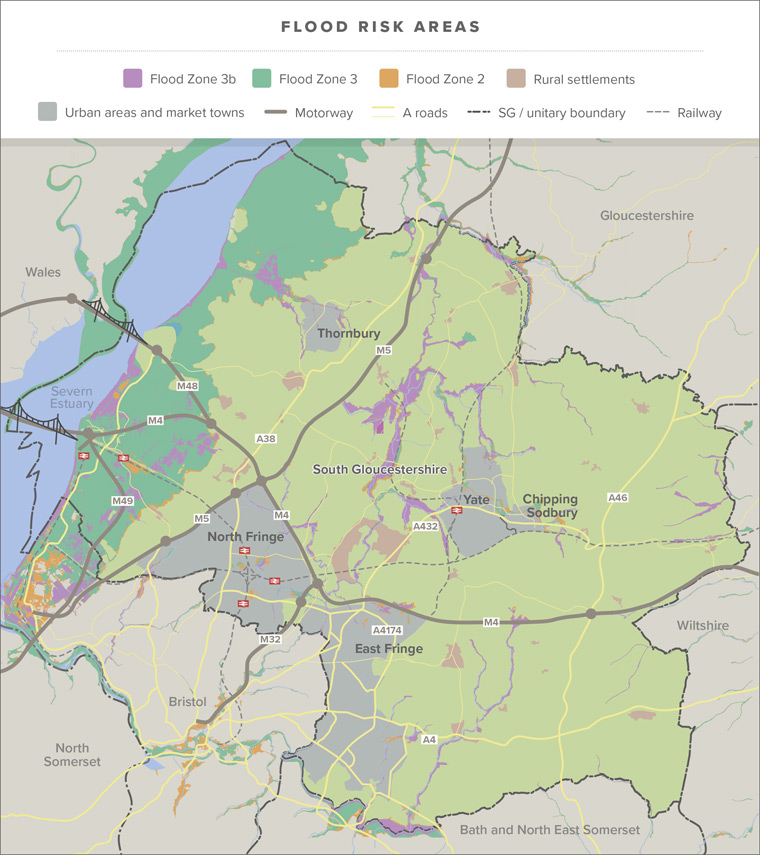
National policy requires our investigation of growth to undertake a sequential approach. This means investigating growth in areas of the highest flood risk, if no locations in the area of lowest flood risk (Flood Zone 1) are available to meet our growth needs. National Planning Policy Framework (paragraph 157) is clear that ’sensitive development’ which, includes the provision of new housing, should be directed away from areas at high risk of flooding, now and in the future.
However, there are also a number of rural communities that lie within the areas of highest flood risk and opportunities to attract investment, growth and regenerate is impacted by flood risk. It is important that we understand the needs and aspirations of these communities, and work with our partners to understand if and how local needs can be met. This will allow communities in the highest areas of flood risk to investigate and understand what their long-term needs might be and ensure that they remain safe and sustainable over the Plan period.
3. Protect and enhance ecological, landscape and heritage designations and their settings.
The natural and historic environment is recognised as an essential tool in helping to deliver the social, economic and environmental benefits that attract people to live and work in the district. The protection and enhancement of our natural and historic environment is at the heart of national policy for achieving sustainable development.

The Covid-19 pandemic has highlighted the importance of access to nature for our health and well-being. In championing our green economic recovery, it is crucial we put the natural environment and a plethora of services – clean air, water, food, biodiversity, shade, recreation and recycling at the heart of all we do.
Ensuring that this guiding principle is followed as we build our growth strategy for new homes and jobs will ensure that Plan priorities relating to “Protect and enhance our environment”, “Creating exceptional places and spaces” and “Development that promotes health and well-being” are realised.
4. Protect and enhance the function and connectivity of our Green Infrastructure and Nature Recovery Networks.
Green Infrastructure (GI), which includes Blue Infrastructure (GI/BI), when planned effectively can create a strategic network of natural and semi natural features, green spaces and rivers and lakes that intersperse and connect villages, towns and cities. Individually, these elements are GI assets, and the roles that these assets play are GI functions.
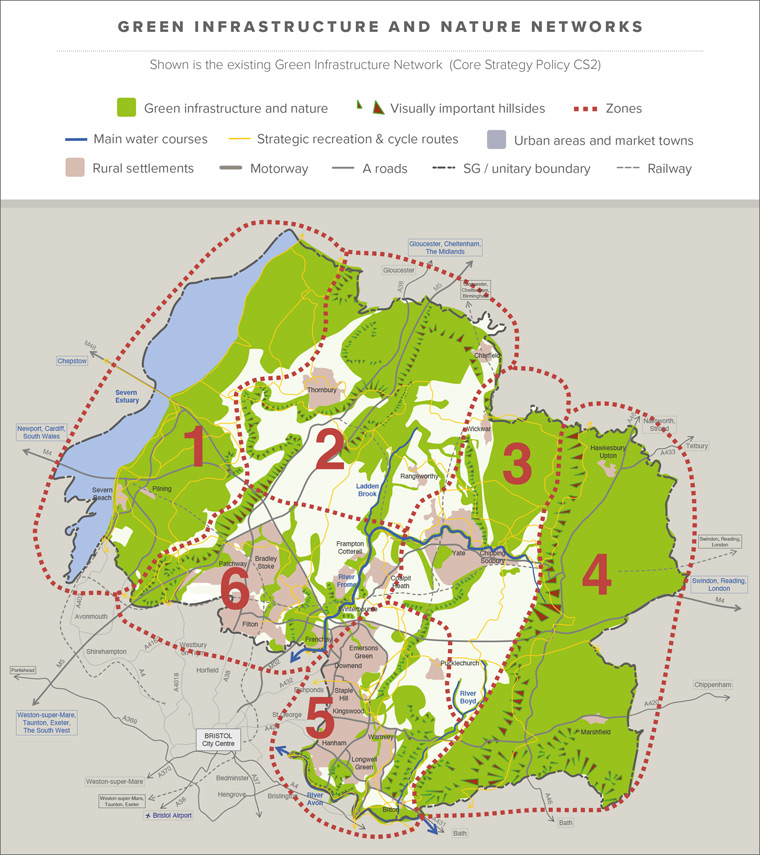
A South Gloucestershire network of GI, including a Nature Recovery Network is currently being developed, and will be informed by the recently published ‘West of England Joint Green Infrastructure Strategy’ (JGIS).
When considering the building blocks and places to investigate for the growth of homes and jobs, it is important that we look to protect and enhance key Green Infrastructure elements and assets, whilst also improving connectivity of the emerging GI and nature recovery networks. This will deliver a wide range of benefits, including:
- adaption to climate change; Green Infrastructure can contribute to carbon storage, cooling and shading, opportunities for species migration to more suitable habitats and the protection of water quality and other natural resources. It can also be an integral part of multifunctional sustainable drainage and natural flood risk management.
- biodiversity/environmental protection; high-quality networks of multifunctional Green Infrastructure contribute a range of benefits, including ecological connectivity, facilitating biodiversity net gain and nature recovery networks and opportunities for communities to undertake conservation work
- access, recreation, play, movement and leisure; Green Infrastructure can improve the well-being of a neighbourhood with opportunities for recreation, exercise, social interaction, experiencing and caring for nature, community food-growing and gardening, all of which can bring mental and physical health benefits
- promoting economic growth, employment and skills improvement the Green Infrastructure can drive economic growth and regeneration, helping to create high quality environments which are attractive to businesses and investors.
- landscape setting and context; Green Infrastructure can reinforce and enhance local landscape character, contributing to a sense of place and natural beauty
- energy production and conservation
- increasing the sustainability of food production, soil health and productive landscapes
- flood attenuation (SuDS) and protection
- cultural heritage
Supplementing our previous principles focused on designated environmental sites, building our growth strategy to protect and enhance networks of Green Infrastructure will have positive effects on many aspects of our priorities relating to “Pursue a carbon neutral and resilient future in a changing climate”, “Protect and enhance our environment”, “Creating exceptional places and spaces” and “Development that promotes health and well-being”.
5. Plan for a better balance between local jobs and resident workers in our communities
It is important that our new Local Plan facilitates a prosperous economy in South Gloucestershire and does so in a way that brings about a ‘clean’ economic recovery from Covid-19 and encourages economic growth that invests in renewable energy, and addresses inequalities in our communities. While our building blocks and growth strategy will seek to provide land for employment growth, our strategy for the growth of homes and jobs will also need to reduce the need to travel for job opportunities and provide new opportunities in communities that have existing inequalities issues, and a lack of access to employment.
Providing opportunities for employment, particularly in those areas of the authority that may have existing inequalities, or where the balance of people to jobs makes finding employment more challenging, will guide decisions of where our strategy focuses large amounts of new homes and jobs.
In addition to meeting our Plan priority that relates to “enabling a productive, clean and inclusive economy”, applying this principle will make sure that our growth strategy contributes to the Plan priorities that relate to, “pursue a carbon neutral and resilient future in a changing climate”, “achieving sustainable travel”, “planning for urban and rural areas”, “provide the right type and number of new homes” and “development that promotes health and well-being”.
6. Ensuring that we protect a ‘sense of place and character’ when we plan for new development
In planning a new strategy for growth, it’s essential to recognise the different characteristics and identities of the urban areas, market towns and rural villages in South Gloucestershire.
New development must be designed so that it is a positive addition to existing communities, in a way that promotes a sense of place, strengthens community identity and reflects local character and key features. This can be guided by planning policies, but our strategy for growth will need to have a positive impact on character and identity.
Well planned growth, should create exceptional places and must respond to the existing natural, built, historic and landscape assets, while enhancing the future character and distinctiveness of each unique area.
Previous levels of growth experienced by a particular area may also be a relevant factor when considering proposals for new development. Consideration will be given to the context of the existing community and the proposed development, as well as the area’s ability to accommodate further growth.
This principle will ensure our growth strategy contributes to the Plan priorities that relate to, “planning for urban and rural areas”, “protect and enhance our environment” and “creating exceptional places and spaces”.
What happens next?
A Call for Sites exercise ran until the end of October 2020. This provided an opportunity for landowners and developers to submit sites to the Council for consideration for housing or economic uses, and developed as part of our new Local Plan. Sites submitted through this process, along with other potential sites identified by the Council or through the SDS consultation, will create an understanding of where growth is being suggested, and subsequently where it could be located.
Once the details of the sub regional SDS are known, we will have a better understanding of the overall number of new homes and jobs that need to be planned for. We can then begin Phase 2 of the Local Plan 2020 consultation and preparation.
Phase 2 of the consultation will consider our overall growth requirements and, using the building blocks and guiding principles, identify where new homes and jobs might be located and where they might need to be protected. It will present potential options and locational choices for consultation.
In August 2020, the government published for consultation a “Planning White Paper”, that proposed significant changes to the planning system and national planning policy. This includes changes to the way Local Plans are produced and what they should include. This will impact on how we progress our new Local Plan, and what we consult you on in future years.
At the moment, we can not be sure what, the exact changes to the planning system and, the new requirements for Local Plans will be.
It is likely to affect the way we present and discuss future options and choices. What is certain however, is that we will be required to plan for new homes and jobs in our area, and through our new Local Plan, we will need to make choices about growth, change and protection in the urban and rural communities of South Gloucestershire. We will also need to set out a new strategy for growth, protection, change and renewal, in South Gloucestershire.
This section begins by raising awareness of what we need to do, and is the starting point in considering how we can begin to think about the choices we might have.
Questions and comments
To answer these questions visit our online consultation page at www.southglos.gov.uk/localplan2020-feedback to complete or download our questionnaire.
Read the next chapter – Urban lifestyles
Go back to the Local Plan 2020 – Phase 1 Issues and Approaches document landing page.